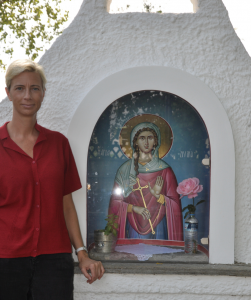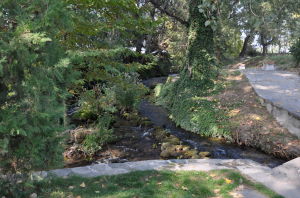“On the Sabbath day we [Paul and his associates] went outside the gate [of Philippi] by the river, where we supposed there was a place of prayer [προσευχὴν; transliteration: proseuch] and we sat down and spoke to the women who had gathered [συνελθούσαις, synelthousais] there” Acts 16:13.
Me standing next to an icon of Lydia on the banks of the “River” Gangites, Philippi, Greece.
This is the place where tradition holds that Lydia assembled with other women (Acts 16:13). Archaeologically there is some controversy whether this is the exact spot but I’ll leave that discussion for another article. What I’m interested in discussing today is whether the site the New Testament describes as a place of prayer [proseuche] was a synagogue and what that meant if only women gathered there.
After reviewing all the uses of gathered, (συνελθούσαις transliteration: synelthousais) throughout the New Testament, the scholar Ivoni Richter Reimer concludes that when a gathering is described as a synelthousais “there is always the idea of a deliberate, purposeful gathering that also implies community” (Reimer, p. 74). From an analysis of Paul’s modus operands of missionary activity throughout his career, he tended to seek out places of Jewish worship upon arriving at a new location and there proclaimed Jesus as the long-awaited Jewish Messiah.
So this place that Paul met women at the banks of a river, was it his usual haunt, the local synagogue, or just a place where the Jewish community prayed? Traditionally scholars have insisted that it couldn’t have been a synagogue service at the banks of the river because ten Jewish men (a minyan) had to be present for an official Jewish assembly. The concept that ten men must be present to legitimate a synagogue service is a later rabbinic ruling that post-dates the story of Lydia. Furthermore, in referring to rabbinic sources “we should be aware that they do not present a unified picture” (Reimer, p.91). According to Megilla 23a, minors and women may be counted among those who can read the Torah aloud in worship, in other words, be considered part of the minimum required to authenticate a synagogue service. Then directly after this ruling comes Megilla 24a which contradicts the first statement because it states that women should not read the Torah in public. In other words, there was a wealth of debate in the Jewish community over whether and how women should be participants in Jewish synagogue services. Therefore, we have no evidence that there was universal agreement that ten participants in synagogue services was required in the mid-first century C.E. regardless of gender. So a gathering of Philippi women praying to a Jewish God could have been a synagogue assembly.
It has been argued for centuries by the dominant exegeses that Philippi had no Jewish community and that’s why there wasn’t an actual synagogue and therefore, women weren’t involved in any “significant” or “official” assembly. Therefore, the women were just silently praying on the banks of the river, nothing more. This is pure supposition. If there wasn’t a Jewish presence in Philippi, then why did Paul go out looking for one, thinking he would find one by the river? The scholar Bernadette Brooten has studied a large variety of ancient sources and has determined that predating the requirement of ten men to form a minyan, ancient tradition allowed women to read the Torah in public and were counted as members of the quorum (Brooten, 94). We simply can’t jump to the conclusion that the women gathered at the bank of the river had nothing to do with a synagogue service.
Unfortunately, there aren’t any other instances of the term “place of prayer” [proseuch] in the New Testament to understand this term better. Taking an interdisciplinary approach, Reimer studied extra-biblical uses of this word. She found that both the early Jewish historian Josephus and his contemporary, the Jewish philosopher, Philo of Alexandria, used the term to describe synagogues (Josephus, Via 277 and Philo Legatio ad Gajum, 155-58). In addition, numerous inscriptions and documents testify that the term proseuch referred to synagogues (Reimer, p. 87, 89, 90).
Therefore, we need to keep in mind the possibility that there exited in Philippi, if not elsewhere, a synagogue mostly composed of women and was considered a legitimate institution by Paul as well as other Jews.
And don’t worry. I’ll write more about Lydia and all the remarkable things we can learn from her.
For Further Reading
Ascough, Richard S. – Lydia: Paul’s Cosmopolitan Hostess. Paul’s Social Network: Brothers and Sisters in Faith. (Collegeville, Minnesota: Order of Saint Benedict, 2009)
Brooten, Bernadette J. – Women Leaders in the Ancient Synagogue: Inscriptional Evidence and Background. Brown Judaic Studies, 36. (Atlanta and Chico, Calif.: Scholars, 1982).
Dewey, Joanna – “From Storytelling to Written Text: The Loss of Early Christian Women’s Voices,” Biblical Theology Bulletin 26 (1996), 71-78.
Gillman, Florence Morgan – “Early Christian Women at Philippi.” Journal of Gender in World Religions [Montreal] 1 (1, 1990): 59-79.
Luter, A. Boyd – “Partnership in the Gospel: The Role of Women in the church at Philippi.” Journal of Evangelical Theological Society 39 (1996) 411-20.
Malherbe, Abraham J. – Social Aspects of Early Christianity. 2nd enlarged ed. (Philadelphia: Fortress, 1983).
Reimer, Ivoni Richter – Women in the Acts of the Apostles: A Feminist Liberation Perspective, Linda M. Maloney, trans. (Minneapolis: Fortress, 1995).
Schottroff, Luise – “Lydia: A New Quality of Power,” in Let the Oppressed Go Free: Feminist Perspectives on the New Testament. Gender and the Biblical Tradition. (Louisville, KY: Westminster John Knox, 1991).
Thomas, W. Derek – “The Place of Women in the Church at Philippi.” Expository Times 83 (1971-72): 117-20.



Hi Robin,
I really enjoyed your article.
I’ve come across the word proseuche several times in my reading. It may not be used elsewhere in the NT, but it comes up many times in Greek literature and inscriptions concerning the Jews in the Diaspora, especially in Egypt. It is a synonym for “synagogue”, especially the building (rather than the people themselves) where Jews gather. (Jospehus also refers to a synagogue at Tiberias as a proseuche.)
I have no doubt that Paul went to the river in Philippi to look for a synagogue, and that is what he found. Many synagogues were built near water (cf Antiquities of the Jews 14.257-58 or 14.10.23.)
The fact that no men are mentioned in Acts 16:13 is puzzling. But I don’t think we can say, just based on this verse, that the synagogue at Philippi had no adult male members.
Thanks for your comment. You made a good point that even though men are not mentioned they might have also been present. Thank you too for all the links to other resources.